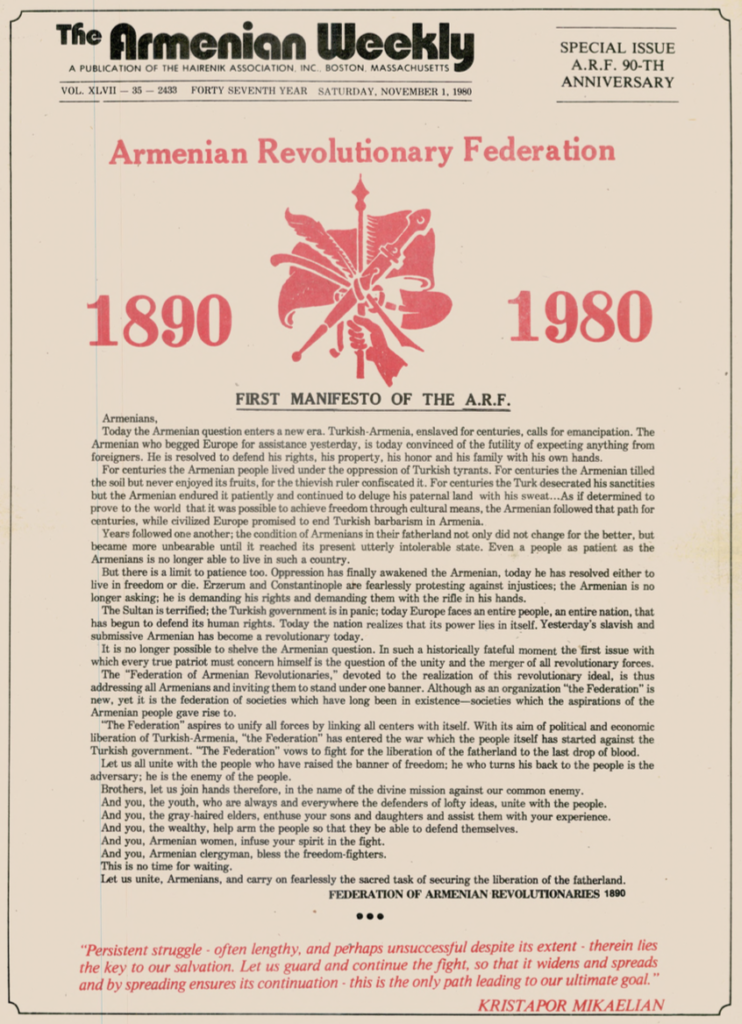
The dzrakir of the Armenian Revolutionary Federation is a living document with a known history and yet a future still to be determined. It is the first manifesto of the ARF, which deals specifically with the liberation of western Armenia and prescribes that the emancipation should come as a result of our own efforts, not relying on the good will of others.
At the time it was written in 1890, the manifesto acknowledged that the Federation was entering a battle already begun by the Armenian people themselves. The manifesto was meant to serve as a rallying cry for all revolutionaries to unify under one banner to overcome the political and economic injustices against the Armenian people.
The dzrakir does not translate easily into English if one is truly to represent its meaning in the context of the ARF. A 1978 publication of the ARF used the term “constitution” to describe it, but also noted that this did not fully encompass the meaning of dzrakir.
Thus, it is clear the dzrakir was meant to reflect the Armenian reality and the struggles of the average person within the homeland. But it was a compromise as well. Two facets exemplify the compromise, first the absence of a specific reference to socialism as a method for economic liberation and second the focus solely on Turkish Armenia.
The document also set a format that would continue to this day, containing both the historical foundation of grievances as well as the methods and practical objectives for remedies.
As the understanding of homeland and injustice expanded, so too did the dzrakir. After the Armeno-Tartar wars of 1905-7 and the oppression of the Tsarist government, the plight of the Armenians in the Caucasus was added to the liberation movement.
Some critics mistake this evolutionary process as lacking discipline. But this kind of agility and fluidity can also be viewed as a sign of organizational strength. It also does not mean that the fundamental concepts and ideology lack timelessness. What more proof is required than the fact that each new generation of ARF-ers joins by taking the same oath as those over a century ago.
The current dzrakir notes some of the following realities:
- The Republic of Armenia contains only a fraction of our rightful homeland.
- The Republic of Artsakh is struggling for international recognition of its right to self-determination.
- The Genocide perpetrated against our people continues to this day with the destruction of our cultural heritage and purposeful altering of the demographic composition of our homeland by the Turkish government. Not only must the crimes end, but justice must be achieved.
- There remains the demand for a Free, United, and Independent Armenia that honors the rule of law and guarantees the economic well-being of each citizen. That is, a democratic Armenia that respects freedom of thought, speech, and press and establishes equality through social justice.
The dzrakir has also focused on the return of all Armenians to our homeland. Today, a number of factors, ranging from unresolved injustices to assimilation, prohibit the achievement of a large-scale, successful repatriation.
In moving forward, there is a need for a full analysis of the Republic of Armenia, the Republic of Artsakh, Javakh, Western Armenia and the Diaspora. The interaction and expectations of the Diaspora beyond being simply a source of repatriation is fundamental to the mission of the ARF in the coming years. If we are to understand the survival of the Armenian people and the achievement of our national goals, we must understand the role and objectives of each of our communities.
The dzrakir has never addressed the Diaspora directly, and that is long overdue.


It need more serious thought and honest exchange of diverse ideas. It can be simple and very short
The editor notes the omission of “socialism” in the manifesto. Why not explain when and where did the manifesto became corrupted and why it plays a prominent theme today? Haven’t we learned anything over these last 100 years?
This explains so much of recent Armenian history. Precedes 1915 by decades.